![]()
CHAPTER 3 - VEGETATION STRUCTURE AS AN INDICATOR FOR LAND-COVER DYNAMICS ASSESSMENT IN THE AMAZON
3.4. Vegetation structure of secondary succession and forest in Machadinho and Anari
3.4.2. What makes a secondary succession stage?
Overall, the comparative analysis of different succession stages and the tropical open forest indicates a significant separation between the classes sampled in the field. Although the process of vegetation recovery happens on a continuous basis, the decision to choose three categories of regrowth was appropriate to characterize distinct structural phases during the process. The analysis of selected structural variables explaining this distinction is presented below.
Figure 18 illustrates the variability in DBH for trees in all classes sampled. It is obvious the trend in increasing DBH from SS1 up to forest. As also expected, there are small overlaps between the extreme values of all classes. The range for DBH of trees in forest sites is the greatest (19.4 to 28.5 cm, Table 8), as well as its distance between the quartiles. The former is explained by the occurrence of emergent individuals competing for light, and the latter indicates the heterogeneity in the average diameter of trees during the first years of recovery. The difference between DBH for all classes is statistically significant at p<0.001 (Table 9).
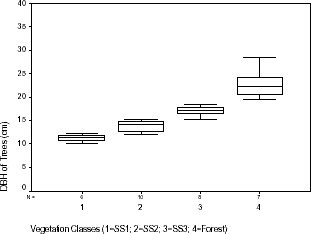
Figure 18 - Distribution of DBH of trees within vegetation classes sampled in Machadinho d’Oeste and Vale do Anari.
Table 9 - Analysis of variance (ANOVA) for vegetation structural variables sampled in Machadinho d’Oeste and Vale do Anari.
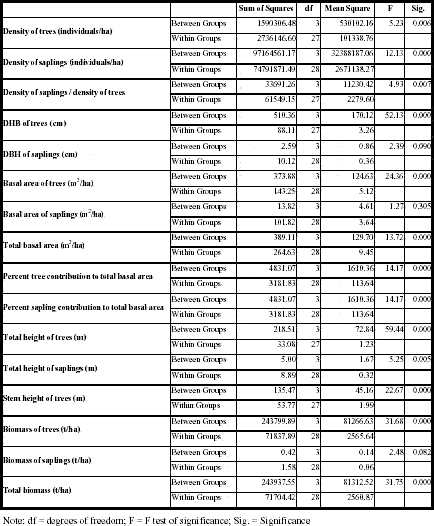
This difference is less significant for DBH of saplings (p<0.09). Although it increases from SS1 to SS3, the upper quartile of a previous class is always overlapping with the lower quartile of the next class (Figure 19). It is important to notice the decrease in DBH of saplings in forest sites. This is due to the effect of shading after SS3, when a closer canopy creates an unsuitable environment for sapling development.
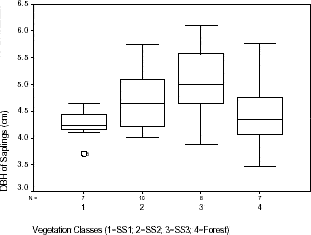
Figure 19 - Distribution of DBH of saplings within vegetation classes sampled in Machadinho d’Oeste and Vale do Anari.
Similar trends are found for basal area of trees and saplings, as its calculation is affected by DBH values. Figures 20 and 21 illustrate basal area distributions for these groups of individuals. For saplings, the classification of regrowth stages is not meaningful (p<0.305) indicating closer values of basal area from SS1 to forest and mainly at the succession stages (Table 9). Results for total basal area follow the increasing pattern from early secondary stages up to forest (Figure 22). This is explained by tree contribution to total basal area (Figure 23). However, the range and variance for all classes of total basal area are greater than basal area for trees because of sapling heterogeneity for this parameter (Figure 24).
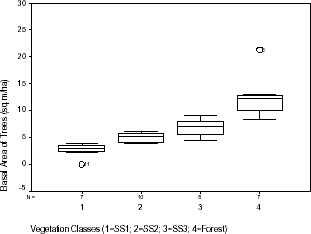
Figure 20 - Distribution of basal area of trees within vegetation classes sampled in Machadinho d’Oeste and Vale do Anari.
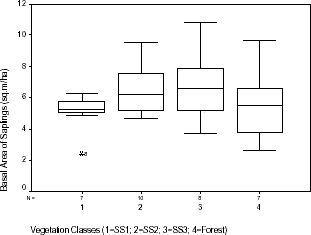
Figure 21 - Distribution of basal area of saplings within vegetation classes sampled in Machadinho d’Oeste and Vale do Anari.
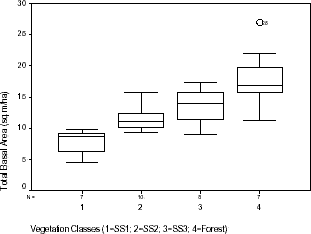
Figure 22 - Distribution of total basal area within vegetation classes sampled in Machadinho d’Oeste and Vale do Anari.
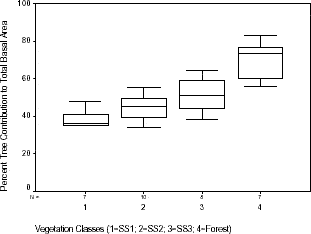
Figure 23 - Distribution of percentage tree contribution to total basal area within vegetation classes sampled in Machadinho d’Oeste and Vale do Anari.
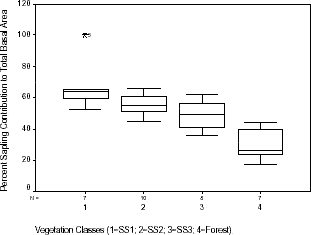
Figure 24 - Distribution of percentage sapling contribution to total basal area within vegetation classes sampled in Machadinho d’Oeste and Vale do Anari.
Total height of individuals is an important parameter indicating the stage of recovery. Figures 25 and 26 illustrate the observed values for total height of trees and saplings, respectively. The former increases significantly from SS1 to forest (p<0.001). Although the height of saplings also increases, overlaps between classes occur more often (p<0.005)(Table 9).
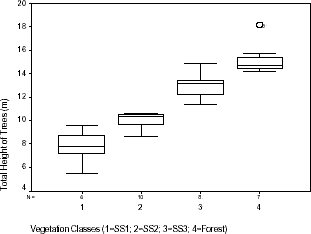
Figure 25 - Distribution of total height of trees within vegetation classes sampled in Machadinho d’Oeste and Vale do Anari.
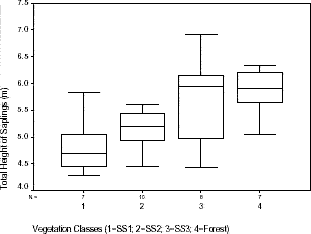
Figure 26 - Distribution of total height of saplings within vegetation classes sampled in Machadinho d’Oeste and Vale do Anari.
Ecologically, these trends are explained by the competition for light within the vegetation community. Trees tend to grow continuously in search of higher canopy layers. As this process occurs, saplings have to deal with the variable availability of light at the understory, which increases their height variance.
The density of trees increases from SS1 to SS3, but decreases at forest sites (Figure 27). Two factors determine this pattern. First, dominant species at SS3 (e.g., Cecropia sp.) die off during the transition to forest. Second, at the forest community level, trees continue to grow in DBH and height but the number of individuals decrease. The trend for density of saplings is the opposite. It constantly decreases from initial stages of regrowth up to forest indicating the importance of trees in more advanced recovery stages (Figure 28). The difference between classes is less significant for trees (p<0.006) than for saplings (p<0.001)(Table 9).
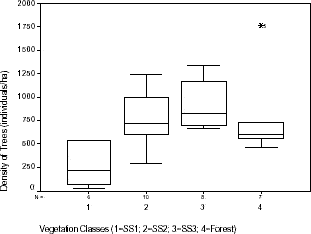
Figure 27 - Distribution of density of trees within vegetation classes sampled in Machadinho d’Oeste and Vale do Anari.
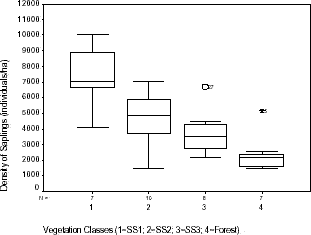
Figure 28 - Distribution of density of saplings within vegetation classes sampled in Machadinho d’Oeste and Vale do Anari.
The relationship of density of saplings and density of trees is depicted by the ratio between these variables. During SS1, this ratio is expressed by a huge variance (Figure 29). Within this stage, the effect of previous land use is more direct, producing different outcomes for vegetation establishment. After SS2, the relationship tends to stabilize as a response to the clear pattern of density change described above.
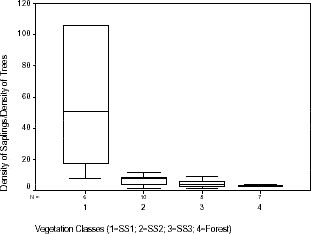
Figure 29 - Distribution of ratio between density of trees and saplings within vegetation classes sampled in Machadinho d’Oeste and Vale do Anari.
As a function of DBH and height, the trends of aboveground biomass from SS1 to forest are affected by those variables. Biomass for trees increases constantly, achieving its highest values in forest formations (Figure 30). The higher variability for forest biomass is related to the larger range in DBH and total height in this class than in stages of regrowth (Tables 5, 6, 7 and 8). Biomass for saplings shows similar trends to that of DBH for saplings (Figures 31 and 19, respectively). It increases from SS1 to SS3, but decreases for forest, due to the lower importance of saplings in open tropical forest environments. Total biomass values behave similarly to tree biomass (Figure 32).
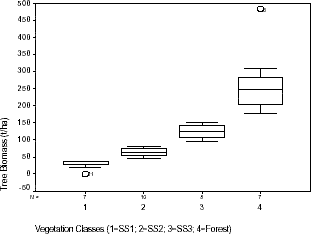
Figure 30 - Distribution of biomass of trees within vegetation classes sampled in Machadinho d’Oeste and Vale do Anari.
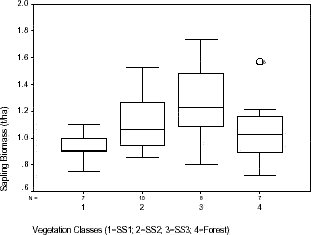
Figure 31 - Distribution of biomass of saplings within vegetation classes sampled in Machadinho d’Oeste and Vale do Anari.
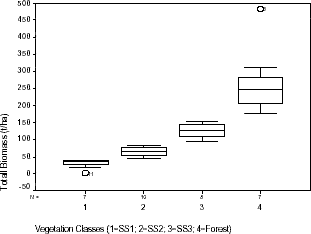
Figure 32 - Distribution of total biomass within vegetation classes sampled in Machadinho d’Oeste and Vale do Anari.